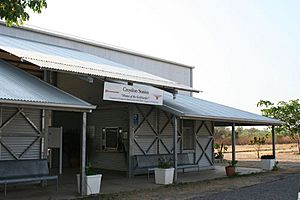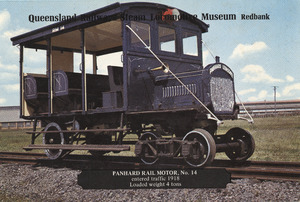Croydon railway station, Queensland facts for kids
Quick facts for kids Croydon railway station |
|
|---|---|

Croydon railway station, 2011
|
|
| Location | Helen Street, Croydon, Shire of Croydon, Queensland, Australia |
| Design period | 1870s - 1890s (late 19th century) |
| Built | c. 1888 - c. 1891 |
| Official name: Croydon Station, Normanton to Croydon Railway | |
| Type | state heritage (built, landscape) |
| Designated | 21 October 1992 |
| Reference no. | 600440 |
| Significant period | 1888-1960s (historical) 1880s-1890s (fabric) |
| Significant components | railway station, crane / gantry, machinery/plant/equipment - transport - rail, ramp, tank - water, shed - storage |
| Lua error in Module:Location_map at line 420: attempt to index field 'wikibase' (a nil value). | |
The Croydon railway station is a special old train station in Croydon, Australia. It was built a long time ago, between 1888 and 1891. This station is at one end of the Normanton to Croydon railway line. This railway line is quite unique because it was built using a special design that allowed it to handle floods. Today, it's still used and is an important part of Queensland's history.
Contents
A Railway Built for Gold
The town of Croydon became very important in the late 1800s because of a huge gold discovery. People needed a way to get supplies and people to the goldfields. So, a railway line was planned to connect Croydon with the port town of Normanton.
The Idea for the Railway
Before the gold rush, there was talk of building a railway from Normanton to another town called Cloncurry. This would help cattle stations and copper mines. However, when gold was found near Croydon in 1885, everything changed. Thousands of people rushed to Croydon, and getting supplies there became a big problem. So, the plan was changed to build the railway to Croydon instead.
A Clever Design for Tricky Land
The land between Normanton and Croydon was very flat. It also flooded often, and there wasn't much good wood for railway sleepers (the pieces of wood or metal that hold the tracks in place). Plus, termites were a problem for wooden sleepers.
A man named George Phillips came up with a smart solution. He designed special U-shaped steel sleepers. These sleepers could be laid directly on the ground. When floods happened, the tracks could be covered by water without being washed away. This meant the railway could be used again quickly after the water went down. The steel sleepers also didn't get eaten by termites! This special system was perfect for the "Gulf country" where the railway was built.
Construction started in 1888. The first part of the line opened in 1889, and the whole line to Croydon was finished by July 1891.
Building Challenges
Building the railway wasn't easy. It was hard to get enough of Phillips' special steel sleepers. They were made in Brisbane and even in Glasgow, Scotland. Sometimes, they had to use wooden sleepers instead, and some bridges that were meant to be steel were built with wood. Later, much of the wood was replaced with steel.
The main railway buildings were at the Normanton end of the line. Because the railway was isolated (not connected to other railway lines), Normanton had many workshops to fix trains. Croydon had smaller buildings, like sheds for goods and locomotives, and a station with a roof over two tracks.
Life on the Line
At first, the railway carried food, mail, passengers, and building materials. It also brought firewood for the mines. In the late 1890s, special trains took people on picnics to water holes and for weekend trips. There was even a "suburban" service between Croydon and the Golden Gate mine, which was a very busy mining town nearby.
Changes Over Time
The gold rush in Croydon didn't last forever. By the early 1900s, gold mining slowed down a lot. The railway only made a profit for a few years. However, it stayed open because it was a very important link for the community, especially during the wet season. The Phillips system worked so well that the tracks could be used almost immediately after floods, while roads stayed muddy and impassable for much longer.
To save money, the railway started using special "railmotors" instead of big steam trains in the 1920s. By 1929, all the steam trains were gone. Even though new roads made the railway less important, it remained a vital transport link until the late 1960s.
Today, the line is mostly a tourist attraction. One of the old railmotors was fixed up and named the "Gulflander" in 1978. It still makes a weekly trip, carrying passengers and even cars. During the wet season, it still carries freight when the roads are flooded.
Sadly, not all the original buildings survived. The Croydon station building was destroyed by a storm in 1969 and was rebuilt in a more modern style.
What You Can See Today
The Croydon station area has a mix of old and new buildings. The current station building is simple, made of corrugated iron. Outside, you can see old "Avery scales" which were used to weigh goods. There's also a round water tank nearby.
You might also spot a very old "Saxby and Farmer lever" from 1887, which is quite rare. The station also has an old "Ransomes and Rapier crane," similar to one at Normanton. This crane is next to the tracks, near where an old goods shed used to be (you can still see its concrete floor). There's also a loading ramp, made from old metal sleepers and rails, though it's a bit broken now. You can even see the tower of an old windmill, made from railway rails, and other old locomotive parts scattered around the yard.
Why This Place is Special
The Croydon railway station and the Normanton to Croydon railway line are listed on the Queensland Heritage Register. This means they are very important to Queensland's history.
- A Glimpse into the Past: This railway shows how Queensland's train system grew, connecting ports to inland resources like goldfields. It also reminds us how quickly gold towns could boom and then fade away.
- One of a Kind: This is the last isolated railway line in Queensland that is still in use! It's also the only full railway line built using George Phillips' special steel sleeper system, which still works today. You can see some rare old equipment here too.
- Learning from History: Because this railway was so isolated, it had its own workshops and kept old trains and equipment longer than other lines. Studying it can teach us a lot about how isolated railways were kept running and the technology they used.
- Smart Engineering: The railway line itself was a very clever invention for its time. The low-level tracks and bridges, along with Phillips' steel sleepers, were designed to handle Queensland's floods. This system has worked well for over a hundred years with little maintenance, proving how smart the design was.
- Connected to a Visionary: The railway has a strong link to George Phillips. He helped explore the area, represented it in Parliament, and most importantly, he designed and oversaw the building of this unique railway.


